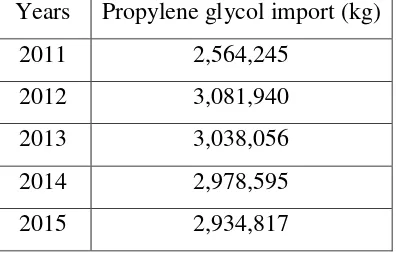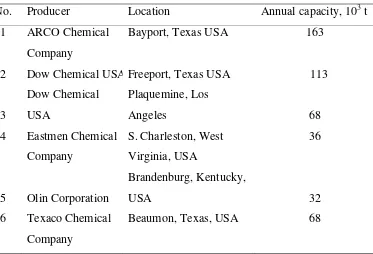CHAPTER I
INTRODUCTION
1.1. Background
In this globalization era, Indonesia as a developing country continue to
show rapid growth especially in the construction industry. One type of industry
that is growing in Indonesia is chemical industry. Indonesia still has to import
many kinds of chemicals to meet the needs. Chemical production Indonesia is not
currently able to meet domestic demand which continues to increase every year.
Upstream industries that produce chemicals supporter or raw materials should
have been able to support the rapid growth of downstream industries that produce
finished products, therefore the need for the development of the chemical industry
in Indonesia. With the establishment of the chemical plant, can save foreign
exchange and create new jobs in the effort to help reduce unemployment and
poverty in Indonesia.
Propylene Glycol with another name 1,2-propanediol is one of the
chemicals widely used in various industries both as raw materials and auxiliary
materials. Usage is very broad in various industries such as food preservative in
the food industry, as softener and moisturizer in the cosmetics industry, as one of
the formulas in the pharmaceutical industry, and as additives in paint products
industry (Kirk and Othmer, 1992).
Based on the description above, the propylene glycol is a chemical that is
very potential to be produced and the necessary establishment propylene glycol
manufacturing plant in Indonesia. Given the magnitude of the needs in the country
1.2. Production Capacity
In determining the production capacity of propylene glycol can reviewed
from various aspects, such as the needs of propylene glycol, industrial capacity
which is already in operation, and the availability of raw materials.
To meet the need of society for propylene glycol, Indonesia importing from other
countries. The need for chloroform in Indonesia from 2011 to 2015 can be seen at
the Table 1.1.
Table 1.1. Import of propylene glycol in Indonesia from 2011 to 2015 (BPS,
2015)
Years Propylene glycol import (kg)
2011 2,564,245
2012 3,081,940
2013 3,038,056
2014 2,978,595
2015 2,934,817
The increased in the imports of propylene glycol are consistent with the equation
of a straight line:
y = 63780x - 1E+08
From this equation, it can be estimated that propylene glycol import in 2020 will
equal to 28,835.6 Tones/year. Based on that estimated need for propylene glycol
[image:2.595.215.413.332.460.2]Table 1.2 Data of propylene glycol production capacity abroad (Chern, 1993)
No. Producer Location Annual capacity, 103 t
1 ARCO Chemical
Company
Bayport, Texas USA 163
2 Dow Chemical USA Freeport, Texas USA 113
3
Dow Chemical
USA
Plaquemine, Los
Angeles 68
4 Eastmen Chemical
Company
S. Charleston, West
Virginia, USA
36
5 Olin Corporation
Brandenburg, Kentucky,
USA 32
6 Texaco Chemical
Company
Beaumon, Texas, USA 68
1.3. Site selection
There are several factors which affect selection of locations where
propylene glycol manufacturers should be established and Gresik is the right
choice for the following reasons:
1. Sources of the Raw Materials
The plant of propylene glycol belongs to the process of weight reduction
and thus the plant should be built near the sources of raw material. The main
raw materials include Propylene oxide from Zhangdian Petrochrm China,
Sulfuric acid from PT. Petrokimia Gresik, Sodium Hydroxide from
PT.Perdana Mulia Jaya Surabaya, Methanol from PT. Kaltim Methanol
Industry Kalimantan and Water from Brantas and Bengawan Solo river.
2. Product Marketing
East Java is an industrial area, both small and large industrial industry
which is a potential market in the production of propylene glycol.
To supply the raw materials, it can be carried out using sea transportation
is used through Tanjung Perak port which has adequate facilities. As for
product marketing, Gresik near from Surabaya, and Surabaya has a very
complete transportation by land, sea and air is very supportive for marketing.
4. Labor Force
The labor force of the plants is requited from Gresik and its surrounding
areas, in which the population in this area is high, marketing it a potential
source of labor force.
1.4. Literature Reviews
Propylene glycol can be produced by the hydrolysis of propylene oxide
with excess water. Can also by adding methanol as a diluent for propylene oxide
is not soluble in water.
1.4.1. Types of Processes
Production of propylene glycol can be done with 3 processes, among others:
a. Hydration of propylene oxide without a catalyst
Reaction :
CH2– CH – CH3 + H2O → CH3– CH – CH2 (1.2)
O OH OH
The conversion of propylene oxide hydration process without catalyst reaches
90%. This process takes place at temperatures of 120-190°C at a pressure of
2,170 kPa (Kirk and Othmer, 1992).
.
b. Hydration of propylene oxide with a catalyst
Reaction:
H+
CH2– CH – CH3 + H2O → CH3– CH – CH2 (1.3)
At Chan and Seider study in 2004 using the reaction of propylene oxide ratio
as much as 43.04 lbmole with water and methanol as lbmol 802.8 71.87
lbmol and sulfuric acid as a catalyst of 20 lbmol. The process operating
conditions on the use temperature of 77-93°F with a pressure of 1 atm,
obtained a conversion of 99% (Chan and Seider, 2004)
.
So, by looking at the process conditions and the resulting conversion on
every production process propylene glycol above, the selected process is the
hydration of propylene oxide with an acid catalyst.
1.4.2. The Use of Product
Propylene glycol known antimicrobial and is an effective food
preservative. Propylene glycol also finds use as a solvent in elixirs and
pharmaceutical preparation containing some water soluble ingredients, and as
solvent and coupling agent in the formulation of sunscreen lotion, shampoos,
shaving creams and other similar products. The industrial grade of propylene
glycol is an important intermediate in the production of alkyd resins for paints
and varnish (Kirk and Othmer, 1992).
1.4.3. Physical and Chemical Properties
A. The Primary Raw Materials
1. Propylene Oxide
a. Physical properties of Propylene Oxide (Kirk and Othmer, 1992) :
Molecular weight : 58.10 g/gmol
Density : 0.82 g/cc
Purity : 99.95%
Melting point : -111.93°C
Boiling point at 1 atm : 34.27778°C
b. Chemical properties of Propylene Oxide :
- Reaction with water
Propylene oxide reacts with water, either with an acid catalyst or a
base catalyst even without a catalyst
- reaction with ammonia
If it reacts with ammonia to form mono-, di-, tri-isopropanalamine.
reacts with primary amines to form secondary and tertiary amines.
- reaction with organic acids
If it reacts with organic acids to form glycol mono-ethers
- reaction with natural products
If it reacts with the hydroxyl groups in the sugar cellulose and
glycol with an alkaline catalyst, it forms hydroxyl propyl ether and
ether and glycol derivatives.
2. Water
a. Physical properties of Water (Perry, 1999) :
Molecular weight : 18.01 g/gmol
Melting point at 1 atm : 0°C
Boiling point at 1 atm : 100°C
Critical pressure : 218 atm
Critical temperature : 374.20°C
Heat of fusion : 1.43 kkal/gmol
Heat of vaporization : -68.31 kkal/gmol
Refractive index : 1.33
Density at 25°C : 1.02 g/cc
Viscosity : 0.69 cp
a. Chemical Properties of Water :
- Easy dissolving liquid, solid or gas
3. Sulfuric Acid
a. Physical properties of Sulfuric Acid (Perry, 1999) :
Molecular weight : 98.08 g/mol
Purity : 98%
Phase : Liquid
Boiling point at 1 atm : 340°C
Melting point : 10.49°C
Density : 1.84 g/ml
b. Chemical Properties of Sulfuric Acid (Fessenden, 1992) :
- If reacted with HNO3 will produce nitrite ions / nitronium (NO2 +)
are useful in the nitration reaction
- HONO2 + 2H2SO4 → 2H2SO4- + NO2+ + H3O+ (1.5)
- H2SO4 in the nitration reaction has the function of preventing
HNO3 to form hydrogen ions (H +) and nitrate (NO3-) and form the
nitronium ion (NO2+)
- H2SO4 has a pull force of the water and generates a large hydrate
compounds such as H2SO4.H2O and H2SO4.2H2O
4. Sodium Hydroxide
a. Physical Properties of Sodium Hydroxide (Kirk and Othmer, 1992) :
Molecular weight : 39.99 g/mole
Purity : 50%
Phase : Liquid
Boiling point at 1 atm : 1.388°C
Melting point : 318°C
Density at 20°C : 2.13 g/ml
Latent heat : 167.40 kJ/mole
In this process NaOH as neutralizer of nitric acid
Reaction:
HNO3+ NaOH → NaNO3 + H2O (1.6)
H2SO4+ 2NaOH → Na2SO4 + 2H2O (1.7)
5. Methanol
a. Physical Properties of Methanol:
Molecular weight : 32.04 g/mole
Purity : 99.98%
Phase : Liquid
Color : Colorless
Boiling point at 1 atm : 64.75°C
Melting point : -97°C
Density at 30°C : 782.81 kg/m3
Viscosity at 30°C : 0.51 CP
Critical temperature : 239.43°C
Critical pressure : 79.81 ATM
Purity : > 85% w of methanol
Impurity : < 15% w of water
b. Chemical Properties of Methanol:
- The reaction with methanol occurs by breaking the C-O group and
-H bond.
B. Main Products
1. Propylene Glycol
a. Physical Properties of Propylene Glycol (Kirk and Othmer, 1992) :
Molecular weight : 76.09 g/gmole
Purity : 99.50%
Melting point at 1 ATM : -60°C
Heat of vaporization : 12.94 Kkal/gmole
Refractive index : 1.43
Density at 25°C : 1.03 g/cc
Viscosity : 0.58 cp
Specific heat : 0.59 kal/g°C
a. Chemical Properties of Propylene Glycol :
- Propylene glycol is used as an initiator in the base catalyst to
produce mono (primary and secondary) and Dieter (polyether
polyols)
- Propylene glycol condensation with the aldehyde produce a cyclic
acetyl or 4 methyl 1.3 dioxin
- Propylene glycol esterified with maleic, fumaric or similar results
acids like halide or anhydride acid produces mono and di-esters

